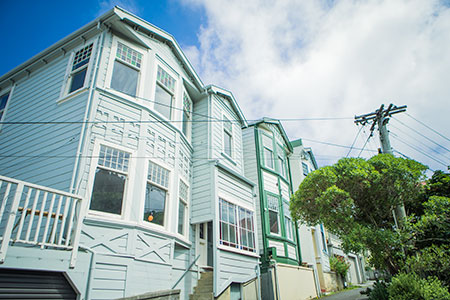Thorndon is the oldest suburb in New Zealand and lies at the northern end of Wellington’s central business district. It is flanked by the green town belt on Te Ahumairangi Hill to the west and the port facilities of Wellington Harbour to the east.

We acknowledge with appreciation the funding support we receive from Wellington City Council.


Thorndon’s History
Thorndon is a suburb steeped in history. As well as being home to Parliament, it also contains several sites of particular significance in Wellington, such as Katherine Mansfield House, Old St Paul’s, and one of New Zealand’s oldest public houses, the Thistle Inn.
Built in the 1960s, the Wellington Urban Motorway cut through Thorndon, separating its largely residential area with its business area. Close to the city centre, the railway station and motorway make the suburb’s heritage sites easily accessible.
Thorndon also houses several embassies and consulates, such as the Australian High Commission, as well as the embassies of the Republic of the Philippines, Germany, and Cuba. It is also the official residence of the French Ambassador.
Architecture
Being one of New Zealand’s oldest residential suburbs, Thorndon has a diverse architectural history. Settlers surveying and building in Thorndon in the 1840s divided the land into one acre sections, which is still evident within the area today.
Because of its steep landscape, parts of Thorndon has architecture unlike anywhere else in New Zealand. The social divisions of the 19th century are clear in the division between the large houses built on the flat land in the north of the suburb, and the workers’ houses built on the sloped landscape to the south.
There was a surge in prosperity by the turn of the century, and many substantial homes were designed by leading architects.
William Clayton – New Zealand’s first and only colonial architect – designed many significant buildings in Wellington, but is perhaps best known for designing Parliament buildings and Government House. He also constructed the first building in the country made of concrete, a house on Hobson St which has been incorporated into Queen Margaret College.

Ernst Plischke, an Austrian architect was one of the key figures to introduce modernism into Thorndon architecture after the Second World War, and worked on designs for housing blocks to be built in Wellington by the government.
The Wellington Urban motorway cut through the area in the 1960s, which resulted in the destruction of about 400 houses. This led to a greater awareness of Thorndon’s heritage, and in the 1970s the Thorndon Society and Thorndon Trust were formed to preserve and protect the areas historic buildings.


Remove Graffiti from Thorndon
A Thorndon Residents’ Association communication initiative; collaboration between WCC and residents. The aim is to help protect the community from property vandalism in the form of graffiti. Vandalism locations, patterns and clean-up response stand-out when they are tracked on an interactive map. Click here to view the Safety and Graffiti map.
Character Zone
Because of Thorndon’s rich history, with many of its buildings providing a snapshot in time of the mid-nineteenth century, Wellington City Council has decided to ensure new buildings in Thorndon adhere to a code to protect its special character.
The majority of buildings in Thorndon are over 90 years old, so the code have been prepared to ensure all buildings have a certain cohesiveness. The design guide provides the criteria for all prospective buildings, and although is flexible, it ensures all new buildings maintain the character of Thorndon.
For more information on the planning codes, take a look at the design guide
